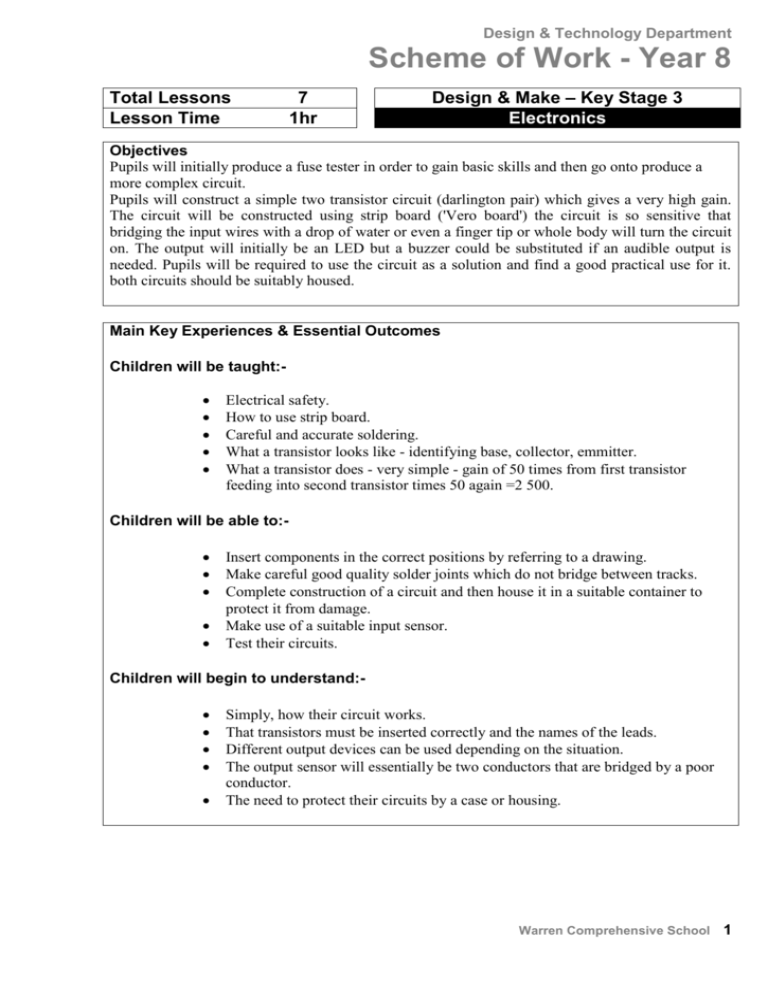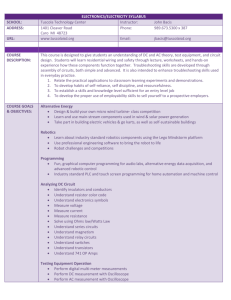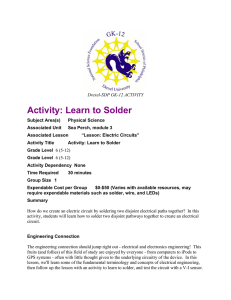Electronics - Warren Design & Technology Revision
advertisement

Design & Technology Department
Scheme of Work - Year 8
Total Lessons
Lesson Time
7
1hr
Design & Make – Key Stage 3
Electronics
Objectives
Pupils will initially produce a fuse tester in order to gain basic skills and then go onto produce a
more complex circuit.
Pupils will construct a simple two transistor circuit (darlington pair) which gives a very high gain.
The circuit will be constructed using strip board ('Vero board') the circuit is so sensitive that
bridging the input wires with a drop of water or even a finger tip or whole body will turn the circuit
on. The output will initially be an LED but a buzzer could be substituted if an audible output is
needed. Pupils will be required to use the circuit as a solution and find a good practical use for it.
both circuits should be suitably housed.
Main Key Experiences & Essential Outcomes
Children will be taught:
Electrical safety.
How to use strip board.
Careful and accurate soldering.
What a transistor looks like - identifying base, collector, emmitter.
What a transistor does - very simple - gain of 50 times from first transistor
feeding into second transistor times 50 again =2 500.
Children will be able to:
Insert components in the correct positions by referring to a drawing.
Make careful good quality solder joints which do not bridge between tracks.
Complete construction of a circuit and then house it in a suitable container to
protect it from damage.
Make use of a suitable input sensor.
Test their circuits.
Children will begin to understand:
Simply, how their circuit works.
That transistors must be inserted correctly and the names of the leads.
Different output devices can be used depending on the situation.
The output sensor will essentially be two conductors that are bridged by a poor
conductor.
The need to protect their circuits by a case or housing.
Warren Comprehensive School1
Design & Technology Department
Programmes of Study
1a, 1b, 2a, 3b, 3c, 3d, 3e, 3f, 3g, 3h, 3i, 3j, 3l, 4c, 4d, 4i, 4j, 4k,
6a, 6c, 6d, 6e, 6f, 6g, 8c, 9a, 9c, 10a, 10b, 10c
Assessment
Possible levels: 4-6
Planning - step by step.
Recording of changes made.
Accuracy during all stages of making - in particular - joints and soldering.
Applying knowledge and understanding
Working with materials.
Evaluating.
Differentiation
Worksheets provided
In the main by outcome (following instructions, accuracy and finish) according to the groups
ability.
Additional research can be introduced for extension activities.
RESOURCES
Equipment
Tenon saw
Bench hook
Coping saw
Rasps
Files
Glass paper
Materials
Soldering iron
Wire cutters
Pliers
Drill bits
Pillar drill
Hammer
Wood housing
MDF
Styrene
Transistors
LEDs
Resistors
Capacitors
Vero board
Various other
electronic components.
Literacy
Word search for homework.
Literacy
Oral, reading, writing.
Numeracy
Measuring, marking out
ICT opportunities
Work sheets
Personal qualities
Recapping
Interpersonal skills
Working with each other.
Links to other subjects
Science, Art, Maths, English
Warren Comprehensive School2
Design & Technology Department
The programme
Lesson
Details
One
Introduce pupils to project:
Discuss the effects on our modern day life.
Life without electricity and especially electronics.
Issue worksheet - touch switch - Explain briefly the function of the circuit - fill in
box for possible uses.
Add colour to enhance the sheet and aid in construction.
Homework: List 10 electronic / electrical items in the home. State what they do.
Briefly state how people managed before electricity.
Two
Review Homework
Issue component kits for touch switch.
Demonstrate soldering - use 5 seconds heat and 3 seconds solder technique.
Safety with soldering irons and how to deal with burns.
Use giant models to explain how to place components.
Start practical - students to check each component position with teacher before
soldering.
Three
Four
Review Homework
The resistor colour code.
Produce coloured diagrams and examples.
Brainstorm ideas for packaging electronic circuits. Using found items and
commercial tubes and sheet materials.
Five
Complete and test circuit.
Homework: Electronics word search.
Set the design problem - A manufacturer has several thousand of these circuits
surplus to needs. Package these into a useful device to turn loss into profit!
Produce a bubble chart to generate ideas such as rain alarm, touch activated door
bell, water level in bath, making tea alarm for the blind etc.
Questions to ask before designing product.
How big is the battery?
Where is the buzzer or LED to be located?
How will the circuit be fitted inside the container?
Homework: Learn resistor code for test.
Collect suitable materials for making containers...
Warren Comprehensive School3
Design & Technology Department
Six
Review Homework
Practical demonstration of techniques that can be used to manufacture containers.
- tubes, vacuum forming of boxes, engraving machine to cut perfect circles and
even complete boxes. wooden tubes and boxes.
Begin design work
Homework: Annotate ideas to show simple constructional detail.
Seven
Review Homework
Assemble
Evaluation
End of project test.
Evaluation
Notes
Warren Comprehensive School4











